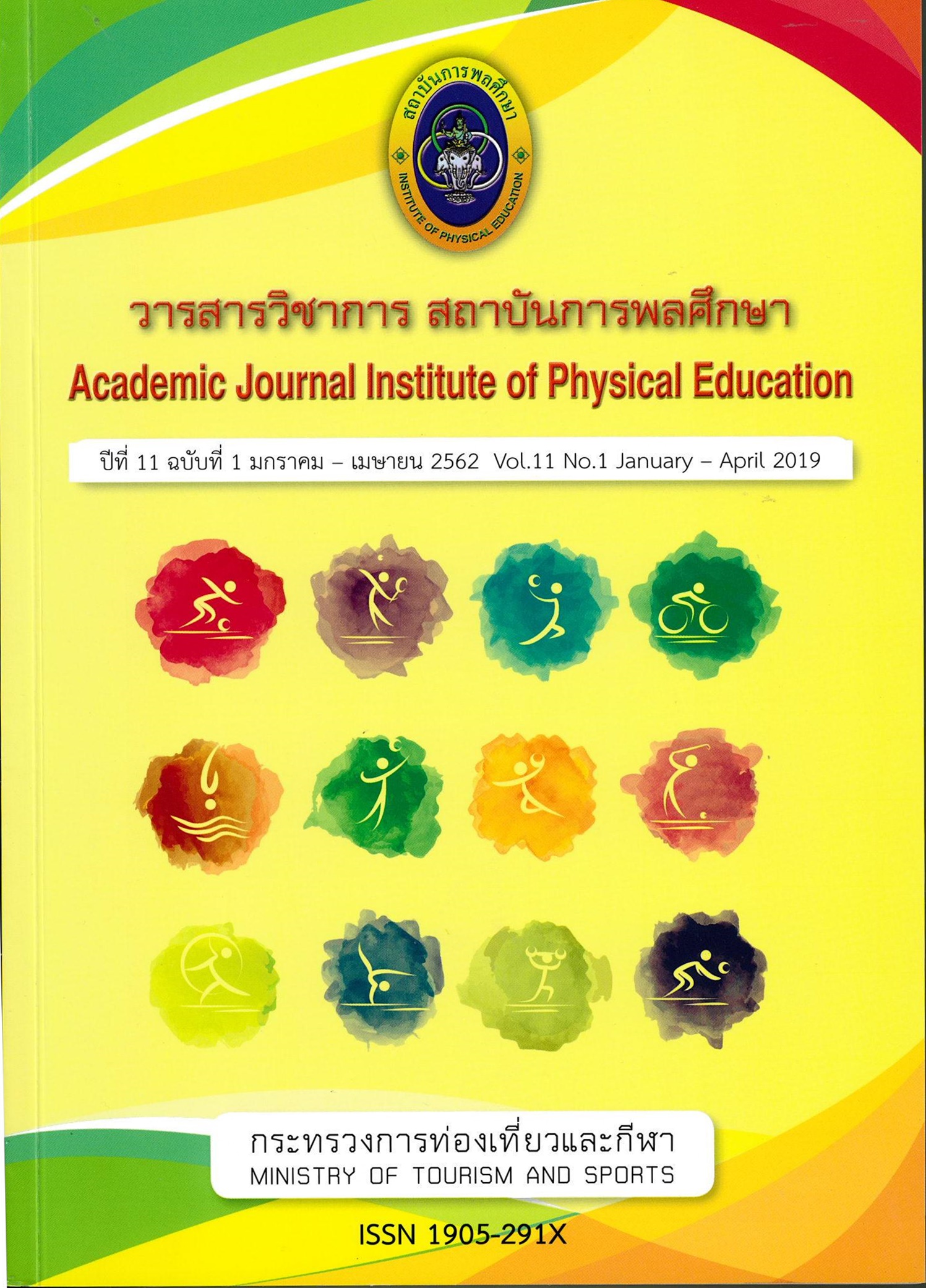Influential Factors in The Competition Success of Thai Professional Boxers in a Standard Boxing Ring in Thailand
Main Article Content
Abstract
The purpose of this study was to examine factors that led to competition success of the Thai Boxing Championships in Thailand. The research instrument was a self-administered questionnaire of factors that influenced the success of professional boxers Fifty-two samples were selected by purposively sampling from Thai boxing champions and the top rank boxers at Ratchadamnoen and Lumpini (13 classes) Boxing Stadium. Data were analyzed by using mean, standard deviation, frequencies and percentages.
The research findings were as follows: - (1) psychological and attitude factors in internal factors of Thai boxing professionals in Thai boxing arena were in high level ( = 4.08, S.D. = 0.22). When considering in each factor, Thai boxers prefer mostly to have fame in society (
= 4.08, S.D. = 0.51). The overall of special capacity of Thai professional boxers in standard boxing ring was in the high level (x̄ = 3.93, SD = 0.19). When considering in each item, Thai boxers were able to lose and control their weight at the highest level (
= 4.40 / 4.27, S.D. = 0.98). The overall of social and cultural factors of the Thai boxers were at High level (
= 3.80, S.D. = 0.24). When considering in each item, the matchmaker of the manager of competition (promoter) was in the highest level (
= 4.54, S.D. = 0.64). The overall of economic factor of Thai boxer was at high level (
= 3.70, S.D. = 0.15). When considering in each item, promoting support promoters was in the highest level (
= 4.46/, 3.75, S.D. = 0.75).
Article Details
The published article is a copyright of the Academic Journal of Thailand National Sports University. The passage appeared in each article in this academic journal is a perspective of each author which is not related to the journal. Each author is required to be responsible for all components of his/her own article. If there are any mistakes, each author must be responsible for those mistakes on his/her own.
References
กรมส่งเสริมวัฒนธรรม กระทรวงวัฒนธรรม. (2555). วันมวยไทย. กรุงเทพ: อักษรศิริการพิมพ์.
กรมส่งเสริมวัฒนธรรม กระทรวงวัฒนธรรม. (2555). มรดกภูมิปัญญาทางวัฒนธรรมของชาติ.กรุงเทพ: อักษรศิริการพิมพ์.
การกีฬาแห่งประเทศไทย. (2540). แผนพัฒนาการกีฬาแห่งชาติ ฉบับที่ 3 (พ.ศ. 2545 -2549).กรุงเทพฯ: การกีฬาแห่งประเทศไทย.ถ่ายเอกสาร.
การกีฬาแห่งประเทศไทย. (2556). แผนยุทธศาสตร์การส่งเสริมกีฬาอาชีพ พ.ศ. 2556-2558.กรุงเทพ: การกีฬาแห่งประเทศไทย.ถ่ายเอกสาร.
จำรัส จันเป็ง. (2552). การวิเคราะห์เชิงคิเนติคร์ท่าไม้ตายของมวยไทย.ปริญญานิพนธ์มหาบัณฑิต สาขาวิชาวิทยาศาสตร์การกีฬา มหาวิทยาลัยเชียงใหม่.
ประทุม ม่วงมี. (2527). รากฐานทางสรีรวิทยาของการออกกำลังกายและพลศึกษา.ปริญญานิพนธ์ กศ.ม. (พลศึกษา). กรุงเทพฯ:บัณฑิตวิทยาลัย มหาวิทยาลัยศรีนครินทรวิโรฒ.
โพธิ์สวัสดิ์ แสงสว่าง. (2556). มวยไทยโบราณ.วิทยานิพนธ์ วิทยานิพนธ์ ศศ.ด.(สาขาวิชามวยไทยศึกษา) ราชบุรี:บัณฑิตวิทยาลัย มหาวิทยาลัยราชภัฏหมู่บ้านจอมบึง.
รุ่งอรุณ สุทธิพงษ์. (2557). การพัฒนาหลักสูตรพิเศษครูมวยไทยระดับสูงสำหรับยอดนักมวยไทย.วิทยานิพนธ์ ศศ.ด.(สาขาวิชามวยไทยศึกษา) ราชบุรี:บัณฑิตวิทยาลัย มหาวิทยาลัยราชภัฏหมู่บ้านจอมบึง.
วิทยา ศรีสมุทร. (2541). แรงจูงใจใฝ่สัมฤทธิ์และทัศนคติต่อการออกกำลังกายของนักมวยไทยอาชีพ.วิทยานิพนธ์ ศษ.ม. (สาขาวิชาพลศึกษา). ขอนแก่น: บัณฑิตวิทยาลัย มหาวิทยาลัยขอนแก่น.
วิสุทธ์ ทิพย์พงษ์. (2546). การศึกษาสภาพและปัญหาการพัฒนากีฬามวยไทยเพื่อการอาชีพ. วิทยานิพนธ์ ค.ม. (พลศึกษา). กรุงเทพฯ: บัณฑิตวิทยาลัย จุฬาลงกรณ์มหาวิทยาลัย.
ศักดิ์กันยา มหาวิน. (2555). การดำรงชีวิตของอดีตแชมป์เปี้ยนนักมวยไทยอาชีพในจังหวัด แพร่ จากเวทีราชดำเนิน เวทีมวยลุมพินีและเวทีกองทัพบก.วิทยานิพนธ์ ค.บ. (สาขาวิชามวยไทยศึกษา) ราชบุรี: บัณฑิตวิทยาลัย มหาวิทยาลัยราชภัฏหมู่บ้านจอมบึง.
สนอง คูณมี. (2549). แรงจูงใจในการเป็นนักมวยไทยอาชีพของนักมวยไทยในเวทีมวยมาตรฐานปีพ.ศ. 2549.ปริญญานิพนธ์ กศ.ม.(พลศึกษา). กรุงเทพฯ: บัณฑิตวิทยาลัย มหาวิทยาลัยศรีนครินทรวิโรฒ.
อนันต์ เมฆสวรรค์. (2559, 14 ตุลาคม). สัมภาษณ์โดย ณัฏฐวุฒิ ชยันโต.


